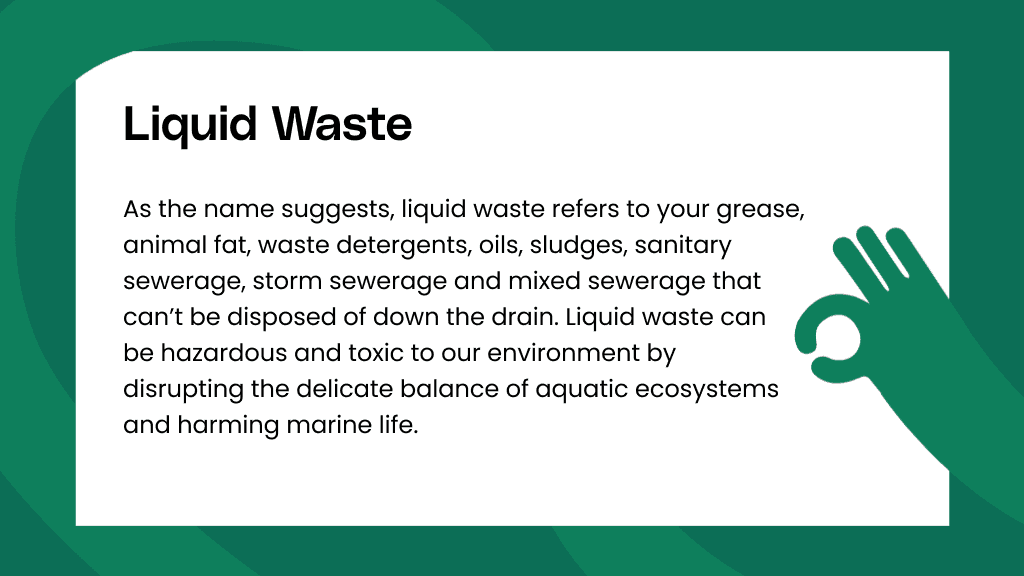Top Guidelines Of Reclaim Waste
Wiki Article
Reclaim Waste Fundamentals Explained
Table of Contents8 Easy Facts About Reclaim Waste ExplainedEverything about Reclaim WasteThe Ultimate Guide To Reclaim WasteUnknown Facts About Reclaim WasteSome Known Incorrect Statements About Reclaim Waste
Explore the kinds, occurrences, and kinds of liquid waste. Domestic sewer waste refers to the waste and items from a residential septic container. This sort of waste is created by people in houses, colleges, and other structures. This only includes sewage-disposal tanks that have a drain area. The correct administration and disposal of domestic sewage waste call for liquid waste to be moved to a sewage therapy plant where the proper methods and devices are related to cleanse and dispose of waste.
Industrial waste commonly includes prospective dangers, such as flammable materials or a blend of liquid and solid waste products, and needs a more sophisticated and detailed disposal process. The disposal of business waste commonly involves the purification of waste before transport to make sure safe and correct disposal. Industrial waste is produced from by-products and overflow of commercial procedures and manufacturing.
This sort of waste can not make use of the very same sewage management transport or processes as septic or industrial liquids. The hazardous waste monitoring process needs the inspection and testing of liquid waste before it undertakes the disposal procedure (liquid waste removal melbourne). Runoff waste is the fluid waste that originates from overflow and excess stormwater in highly populated areas or cities
Drainage waste can create contamination and flooding if not dealt with correctly. Ensuring correct waste monitoring can stop catastrophes and decrease ecological damage.
Fascination About Reclaim Waste
Contact PROS Solutions today to learn more about our waste monitoring and disposal solutions and the appropriate means to care for the liquid waste you generate.(https://www.edocr.com/v/pd6avrzq/leonaube33101/reclaim-waste)This so-called 'wastewater' is not just an important source but, after therapy, will be released to our land, rivers or the ocean. Utilized water from commodes, showers, baths, kitchen area sinks, washings and industrial procedures is recognized as wastewater.

water used to cool down equipment or clean plant and devices). Stormwater, a kind of wastewater, is overflow that moves from agricultural and metropolitan locations such as roofing systems, parks, yards, roadways, paths and rain gutters right into stormwater drains, after rain. Stormwater moves without treatment directly to regional creeks or rivers, at some point reaching the sea.
The 3-Minute Rule for Reclaim Waste
In Queensland, many wastewater is treated at sewage therapy plants. Wastewater is transferred from residential or commercial websites through a system of sewers and pump terminals, recognized as sewage reticulation, to a sewer treatment plant.The Department of Natural Resources advises neighborhood federal governments regarding managing, operating and maintaining sewage systems and therapy plants. In unsewered areas, city governments might need homeowners to install individual or house sewer therapy systems to deal with residential wastewater from commodes, kitchen areas, restrooms and laundries. The Division of Natural Resources authorises the usage of home systems when they are verified to be efficient.
In some brand-new neighborhoods, therapy of some stormwater to eliminate clutter, sand and gravel has actually started utilizing gross toxin traps. Wastewater therapy happens in 4 stages: Gets rid of solid matter.
Utilizes little living organisms understands as micro-organisms to damage down and get rid of remaining dissolved wastes and weblink fine bits. Micro-organisms and wastes are included in the sludge.
See This Report about Reclaim Waste
Nutrient removal is not available at all sewage therapy plants due to the fact that it calls for pricey specialized tools. It is coming to be more common in Queensland. Clear liquid effluent produced after therapy may still include disease-causing micro-organisms. If this effluent is released into rivers such as rivers or the sea, the micro-organisms will at some point pass away out.
This typically indicates wastewater has actually to be dealt with or contaminants removed before it can be released to waterways. Many wastewater flows right into the sewerage system. Under the Act, local federal governments provide authorizations and permits for environmentally relevant tasks (ERAs) entailing wastewater releases that might have a neighborhood effect. The division provides approvals and permits to ERAs entailing wastewater releases that may have a local or statewide impact.
Get This Report on Reclaim Waste
Tracking supplies valid details concerning water top quality and can validate that permit problems are being fulfilled. The details gotten via tracking provides the basis for making water top quality choices.Report this wiki page